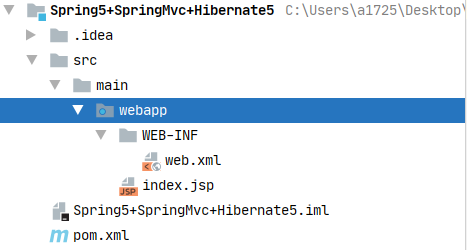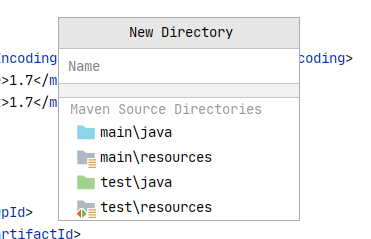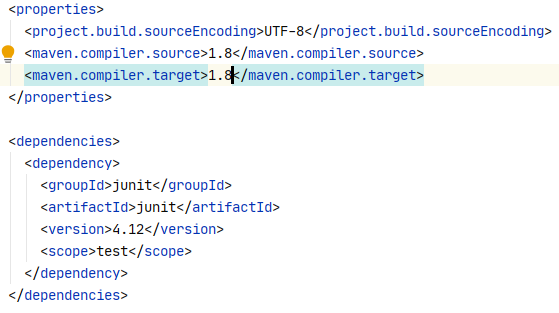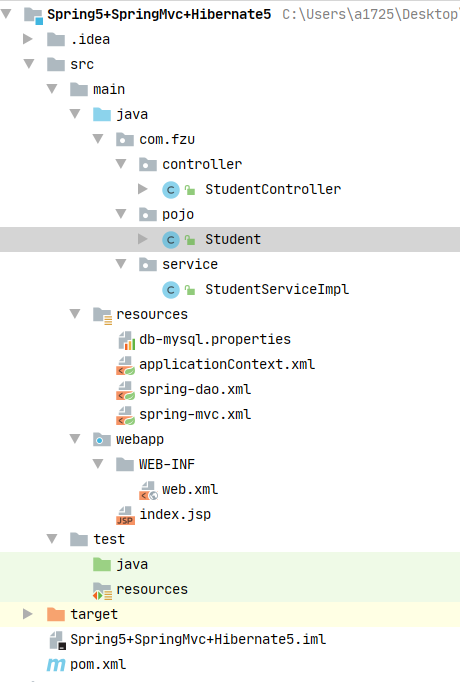Spring5+SpringMvc+Hibernate5整合
Spring5+SpringMvc+Hibernate5整合
在进行环境搭建的时候我发现国内的Spring+SpringMvc+Hibernate整合资料比较少,即使有的话要么就是将所有配置放在一个配置文件,不易于理解结构,要么就是版本太旧,因此这篇文章简单讲解了如何配置相关的开发环境,使用的版本为jdk1.8+spring5+hibernate5
1 分层整合
我们都知道在Spring可以通过<import>标签来将不同的配置文件进行整合的,因此我们就用这个思路来进行整合,我们将全部的配置文件分为dao层,service层和view层,这样整合起来比较方便,也比较容易懂
2 创建项目引入依赖
我们首先创建一个名字为Spring5+SpringMvc+Hibernate5的项目,从原型中找到如下的选项

idea给我们创建的项目默认是不完整的

少了一些文件,我们只需要在src上右键,选择创建对应的文件夹即可


有些低版本的idea可能没有这么只能,你只能手动创建并设置资源和源码目录
创建好了之后我们就可以修改一些pom文件中的配置了,以下的文件可以根据自己的情况进行修改

2.1 引入依赖
- spring依赖
<!--spring依赖-->
<dependency>
<groupId>org.springframework</groupId>
<artifactId>spring-webmvc</artifactId>
<version>5.2.0.RELEASE</version>
</dependency>
<dependency>
<groupId>org.springframework</groupId>
<artifactId>spring-jdbc</artifactId>
<version>5.2.0.RELEASE</version>
</dependency>
<dependency>
<groupId>org.springframework</groupId>
<artifactId>spring-orm</artifactId>
<version>5.2.0.RELEASE</version>
</dependency>
<dependency>
<groupId>org.springframework</groupId>
<artifactId>spring-test</artifactId>
<version>5.2.0.RELEASE</version>
<scope>provided</scope>
</dependency>
- hibernate依赖
<!-- hibernate核心依赖-->
<dependency>
<groupId>org.hibernate</groupId>
<artifactId>hibernate-core</artifactId>
<version>5.2.17.Final</version>
</dependency>
<dependency>
<groupId>org.hibernate</groupId>
<artifactId>hibernate-validator</artifactId>
<version>5.2.0.Final</version>
</dependency>
- 数据库和连接池依赖
<!--连接池依赖-->
<dependency>
<groupId>com.alibaba</groupId>
<artifactId>druid</artifactId>
<version>1.1.10</version>
</dependency>
<!-- 数据库依赖 -->
<dependency>
<groupId>mysql</groupId>
<artifactId>mysql-connector-java</artifactId>
<version>8.0.12</version>
</dependency>
- 引入jsp
<!-- jsp依赖 -->
<dependency>
<groupId>javax.servlet</groupId>
<artifactId>javax.servlet-api</artifactId>
<version>3.1.0</version>
<scope>provided</scope>
</dependency>
<dependency>
<groupId>javax.servlet.jsp</groupId>
<artifactId>jsp-api</artifactId>
<version>2.1</version>
<scope>provided</scope>
</dependency>
<dependency>
<groupId>javax.servlet</groupId>
<artifactId>jstl</artifactId>
<version>1.2</version>
</dependency>
jsp其实不是必须,但是你如果需要用到进行不分离的开发,那么该依赖最好还是引入一下
其他的依赖可以根据自己的情况引入
2.2 构建配置修改
在build的时候有可能会出现静态资源没有build的情况,因此可以采用以下方法
<build>
<resources>
<resource>
<directory>src/main/java</directory>
<includes>
<include>**/*.xml</include>
<include>**/*.properties</include>
</includes>
<filtering>true</filtering>
</resource>
<resource>
<directory>src/main/resources</directory>
<includes>
<include>**/*.xml</include>
<include>**/*.properties</include>
</includes>
<filtering>true</filtering>
</resource>
</resources>
.......
</build>
3 准备数据库
我们在这里准备一个名字为hibernate的数据库,请自行创建,至于数据库表我们则不需要创建
4 配置dao层
我们首先在resources下准备一个db-mysql.properties文件,内容如下
jdbc.driverClassName=com.mysql.cj.jdbc.Driver
jdbc.url=jdbc:mysql://localhost:3306/hibernate?useSSL=false&serverTimezone=Asia/Shanghai&characterEncoding=utf-8
jdbc.username=root
jdbc.password=123456
请根据自己的数据库版本和配置进行书写,当然这一步不是必须的,但是为了方便找到对应配置项,你可准备这个文件
好了我们可以开始进行spring的配置了,在resources文件夹下创建一个spring-dao,xml,这里的名字可以自行决定,在里面输入以下内容
<?xml version="1.0" encoding="UTF-8"?>
<beans xmlns="http://www.springframework.org/schema/beans"
xmlns:xsi="http://www.w3.org/2001/XMLSchema-instance"
xmlns:context="http://www.springframework.org/schema/context"
xmlns:aop="http://www.springframework.org/schema/aop"
xmlns:tx="http://www.springframework.org/schema/tx"
xsi:schemaLocation="http://www.springframework.org/schema/beans
http://www.springframework.org/schema/beans/spring-beans.xsd
http://www.springframework.org/schema/context
http://www.springframework.org/schema/context/spring-context.xsd
http://www.springframework.org/schema/aop
http://www.springframework.org/schema/aop/spring-aop.xsd
http://www.springframework.org/schema/tx
http://www.springframework.org/schema/tx/spring-tx.xsd">
<!-- 开启注解扫描-->
<context:annotation-config></context:annotation-config>
<context:component-scan base-package="com.fzu.pojo"></context:component-scan>
<!-- 加载配置文件-->
<context:property-placeholder location="classpath:db-mysql.properties"></context:property-placeholder>
<!-- 配置数据源-->
<bean id="dataSource" class="com.alibaba.druid.pool.DruidDataSource"
destroy-method="close" lazy-init="false">
<property name="driverClassName" value="${jdbc.driverClassName}" />
<property name="url" value="${jdbc.url}" />
<property name="username" value="${jdbc.username}" />
<property name="password" value="${jdbc.password}" />
<property name="initialSize" value="1" />
<property name="maxActive" value="50" />
<property name="maxWait" value="30000" />
<property name="filters" value="stat,wall" />
<property name="timeBetweenEvictionRunsMillis" value="3000" />
<property name="minEvictableIdleTimeMillis" value="300000" />
<property name="validationQuery" value="SELECT 'x'" />
<property name="testWhileIdle" value="true" />
<property name="testOnBorrow" value="false" />
<property name="testOnReturn" value="false" />
<property name="poolPreparedStatements" value="true" />
<property name="maxPoolPreparedStatementPerConnectionSize" value="20" />
</bean>
<!--配置sessionFactory-->
<bean id="sessionFactory" class="org.springframework.orm.hibernate5.LocalSessionFactoryBean">
<property name="dataSource" ref="dataSource"></property>
<property name="packagesToScan" value="com.fzu.pojo"></property>
<property name="hibernateProperties">
<props>
<prop key="hibernate.hbm2ddl.auto">update</prop>
<prop key="hibernate.dialect">org.hibernate.dialect.MySQL55Dialect</prop>
<prop key="hibernate.show_sql">true</prop>
<prop key="hibernate.format_sql">true</prop>
</props>
</property>
</bean>
<!-- 配置事务管理-->
<bean id="transactionManager" class="org.springframework.orm.hibernate5.HibernateTransactionManager">
<property name="sessionFactory" ref="sessionFactory"></property>
</bean>
<!-- 开启注解事务管理 -->
<tx:annotation-driven transaction-manager="transactionManager"></tx:annotation-driven>
<!--配置hibernatetemplate-->
<bean id="hibernateTemplate" class="org.springframework.orm.hibernate5.HibernateTemplate">
<property name="sessionFactory" ref="sessionFactory"></property>
</bean>
</beans>
请根据自己的情况创建对应的包和选择相应的属性例如数据库方言,我这里是选择了com.fzu.pojo下存放实体类,我创建了一个Student实体类,其中关于hibernate注解的内容我们不赘述
package com.fzu.pojo;
import javax.persistence.Entity;
import javax.persistence.Id;
import javax.persistence.Table;
@Entity
@Table
public class Student {
@Id
private Long studentid;
private String name;
private Integer age;
// 这里请不要用desc,这个是mysql保留字
private String description;
@Override
public String toString() {
return "Student{" +
"studentid=" + studentid +
", name='" + name + '\'' +
", age=" + age +
", description='" + description + '\'' +
'}';
}
public Long getStudentid() {
return studentid;
}
public void setStudentid(Long studentid) {
this.studentid = studentid;
}
public String getName() {
return name;
}
public void setName(String name) {
this.name = name;
}
public Integer getAge() {
return age;
}
public void setAge(Integer age) {
this.age = age;
}
public String getDescription() {
return description;
}
public void setDescription(String description) {
this.description = description;
}
}
最后在applicationContext.xml中引入该文件
<?xml version="1.0" encoding="UTF-8"?>
<beans xmlns="http://www.springframework.org/schema/beans"
xmlns:xsi="http://www.w3.org/2001/XMLSchema-instance"
xmlns:context="http://www.springframework.org/schema/context"
xmlns:aop="http://www.springframework.org/schema/aop"
xmlns:tx="http://www.springframework.org/schema/tx"
xsi:schemaLocation="http://www.springframework.org/schema/beans
http://www.springframework.org/schema/beans/spring-beans.xsd
http://www.springframework.org/schema/context
http://www.springframework.org/schema/context/spring-context.xsd
http://www.springframework.org/schema/aop
http://www.springframework.org/schema/aop/spring-aop.xsd
http://www.springframework.org/schema/tx
http://www.springframework.org/schema/tx/spring-tx.xsd">
<!-- 开启注解扫描-->
<context:component-scan base-package="com.fzu">
<context:exclude-filter type="annotation" expression="org.springframework.stereotype.Controller"/>
</context:component-scan>
<context:annotation-config></context:annotation-config>
<import resource="classpath:spring-dao.xml"/>
<import resource="classpath:spring-mvc.xml"/>
</beans>
由于这里我们service层的内容比较少我们就不单独创建一个配置文件了
5 配置mvc层
创建spring-mvc.xml文件,并输入以下内容
<?xml version="1.0" encoding="UTF-8"?>
<beans xmlns="http://www.springframework.org/schema/beans"
xmlns:xsi="http://www.w3.org/2001/XMLSchema-instance"
xmlns:context="http://www.springframework.org/schema/context"
xmlns:aop="http://www.springframework.org/schema/aop"
xmlns:tx="http://www.springframework.org/schema/tx"
xmlns:mvc="http://www.springframework.org/schema/mvc"
xsi:schemaLocation="http://www.springframework.org/schema/beans
http://www.springframework.org/schema/beans/spring-beans.xsd
http://www.springframework.org/schema/context
http://www.springframework.org/schema/context/spring-context.xsd
http://www.springframework.org/schema/aop
http://www.springframework.org/schema/aop/spring-aop.xsd
http://www.springframework.org/schema/tx
http://www.springframework.org/schema/tx/spring-tx.xsd
http://www.springframework.org/schema/mvc https://www.springframework.org/schema/mvc/spring-mvc.xsd">
<!--注解驱动-->
<mvc:annotation-driven></mvc:annotation-driven>
<!--过滤静态资源 -->
<mvc:default-servlet-handler></mvc:default-servlet-handler>
<!--扫描controller-->
<context:component-scan base-package="com.fzu.controller"></context:component-scan>
<!--视图解析器-->
<bean id="internalResourceViewResolver" class="org.springframework.web.servlet.view.InternalResourceViewResolver">
<property name="prefix" value="/WEB-INF/jsp/"></property>
<property name="suffix" value=".jsp"></property>
</bean>
</beans>
其中视图解析器路径和扫描的包可以自行确定,不要忘记在applicationContext.xml中引入
6 配置web.xml
我们需要在web.xml中配置spring容器,视图servlet和编码servlet
<?xml version="1.0" encoding="UTF-8"?>
<web-app xmlns="http://xmlns.jcp.org/xml/ns/javaee"
xmlns:xsi="http://www.w3.org/2001/XMLSchema-instance"
xsi:schemaLocation="http://xmlns.jcp.org/xml/ns/javaee
http://xmlns.jcp.org/xml/ns/javaee/web-app_4_0.xsd"
version="4.0">
<welcome-file-list>
<welcome-file>index.jsp</welcome-file>
<welcome-file>index.html</welcome-file>
</welcome-file-list>
<!-- 配置请求分发器 -->
<servlet>
<servlet-name>dispatcherServlet</servlet-name>
<servlet-class>org.springframework.web.servlet.DispatcherServlet</servlet-class>
<init-param>
<param-name>contextConfigLocation</param-name>
<param-value>classpath:spring-mvc.xml</param-value>
</init-param>
<load-on-startup>1</load-on-startup>
</servlet>
<servlet-mapping>
<servlet-name>dispatcherServlet</servlet-name>
<url-pattern>/</url-pattern>
</servlet-mapping>
<!-- 配置字符过滤器 -->
<filter>
<filter-name>encodingFilter</filter-name>
<filter-class>org.springframework.web.filter.CharacterEncodingFilter</filter-class>
<init-param>
<param-name>encoding</param-name>
<param-value>UTF-8</param-value>
</init-param>
</filter>
<filter-mapping>
<filter-name>encodingFilter</filter-name>
<url-pattern>/*</url-pattern>
</filter-mapping>
<!-- 监听spring容器自动启动 -->
<context-param>
<param-name>contextConfigLocation</param-name>
<param-value>classpath:applicationContext.xml</param-value>
</context-param>
<listener>
<listener-class>org.springframework.web.context.ContextLoaderListener</listener-class>
</listener>
<!-- 配置session过期时间-->
<session-config>
<session-timeout>15</session-timeout>
</session-config>
</web-app>
在创建完相应的类之后,请不要忘记配置tomcat服务器,再启动之后我们就可以看到相应的表创建了
7 总结
我们首先看一下最后的文件结构

可以看到我们的整个配置过程是模块化的,从dao层往上,每一层都可以单独拆装,除此之外我们项进行其他配置也是很简单的,例如如果我们想要新增一个redis配置
我们可以按照如下步骤
- 引入相关依赖
- 创建db-redis.properties配置文件
- 创建spring-redis.xml配置文件并进行配置
- 在applicationContext中引入即可
可以看到整个过程逻辑很清晰

